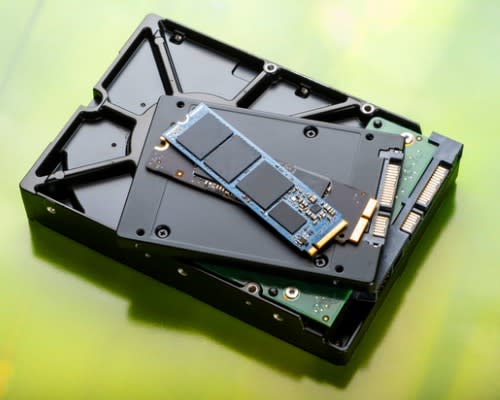
OK. The Great SSD vs NVMe debate, round 12,342. Fight!
But rather than spilling more ink on something that’s been debated nearly to death, let’s define some basic terms and explore what sets these two technologies apart, what each does best, and what applications demand one technology over the other.
What is an SSD?
Solid state drives (SSDs) have been around for a while, but you might not know what’s under the hood, so to speak. An SSD is an alternative to the HDD or hard disk drive that stores the data, applications, and information on a desktop, laptop, or gaming console. They are essentially giant, internal flash drives.
The old hard disks used a magnetic disk to store all those vital ones and zeroes. They had a read/write head that moved over the spinning disk like a record player stylus reading or overwriting the data on a microscopically tiny segment of the disk.
Solid state drives were designed as all-digital, no-moving-parts (hence, the name) alternatives to HDDs that could be plugged directly into existing machines with no problems. They offered faster read/write times, better reliability, lower power usage, and more. Note that they were designed to be plug-and-play compatible with the old technology, so SSDs used the SATA drive controller connections that the old HDDs used.
Generally, they were a big hit. But they were, and still are, more expensive per terabyte than magnetic HDDs.
What is an NVMe?
NVMe stands for Non-volatile memory express. The e refers to the PCIe (peripheral component interconnect express) bus. All NVMe drives are SSDs. But not all SSDs are NVMe.
NVMe is the next design step. It uses the same memory chip technology as an SSD, but it is not intended to be swapped into older systems as easily, so it doesn’t have to limit itself to using the old-style SATA connectors and drive controllers. Instead, an NVMe storage solution plugs directly into the motherboard, using the same CPU bus as the RAM.
SSD vs NVMe
The number one thing you need to know about NVMe vs SATA SSDs is that NVMes are very fast. They’re roughly 20 times faster than the best SATA SSDs.
Similarities: NVMe vs SSD
- As mentioned, both solid-state memory devices replace the hard drive in a computer or games machine.
- Both are non-volatile – meaning that, unlike RAM, the data persists when you turn off the power. And it will still be there when you turn the machine back on.
- Both are faster than HDDs.
- Both come in the M.2 format and the simulated 2.5” disk format.
- Mid-level examples of both drive technology costs around the same amount. Both are more expensive per terabyte than HDDs.
Differences: NVMe SSD vs SATA SSD
- They use different data connections, even if they come in the same form factor. They use different cables or bus sockets for that reason.
- Top-of-the-range SSDs outperform HDDs by a factor of around 4 to 1, while the top-of-the-range NVMes outperform HDDs by nearly 50 to 1.
- The fastest NVMes cost around 1.5 times as much per terabyte as SSD systems.
– Note to graphic artist, include a table comparing similarities and differences
– Note to graphic artist, include a graph comparing the speeds of NVMe and SATA SSDs here

NVMe vs SSD Speed – How Fast is Too Fast?
Mostly, the SSD vs NVMe debate online is about read/write speed. Now, there is a clear difference. NVMe is dramatically faster than SSD and wipes the floor with the old HDDs.
But can you do anything with all that speed? At the moment, few people can. A few applications can take advantage of the R/W speeds NVMe offers, namely FTP file transfers of very big files. If you regularly download, process, and then upload terabyte-scale files and already have an excellent internet connection, then you should make the upgrade. On the client side of the client-server network, though, there is not much point in making the switch just yet – most applications haven’t been written in such a way as to be able to use that speed.
That being said, this time next year, everything could be different.
Who Needs an NVMe?
The NVMe vs SSD debate is about high-end gaming applications. Some people will try to bump up their gaming rig stats. NVMe won’t increase FPS or any other meaningful metric in a home gaming PC. Sorry.
It will improve the load time on really big games, though, and that alone might be worth it for some. However, if you’re comparing load times between SATA SSDs vs NVMe machines, the difference is a handful of seconds on most modern games. Again, they haven’t been written to take advantage of NVMe’s strengths… yet.
Final Thoughts
NVMe drives are the newest generation of SSD and offer several advantages over their predecessors. They are faster, with lower latency, and can connect directly to the PCIe bus. This makes them ideal for gaming machines or other computers that require fast data access. SATA SSDs, while still an improvement on HDDs, cannot match the speed of NVMe drives. If you’re looking to upgrade your computer’s storage, NVMe is the way to go. If you do follow the SSD vs NVMe debate, you’ll know this is just the tip of the iceberg.
[ad_2]
Source link






